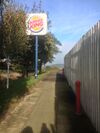Totem Pole
Totem pole is a term often used inaccurately to describe different types of advertising and branded signage, including those at service stations. The placement of these is monitored by the local authority's planning department, which is where the term will be heard most.
In reality, there are different types of advertising sign, which are explained below.
Monopole

A monopole is a single, tall pole, with a brand logo attached to the top of it. It is designed to be clearly visible to passing traffic. The logo at the top is most often that of a fast food brand, like McDonald's or Burger King, but it has also been used to promote WHSmith.
If the pole is only on one side of the sign, as was common with Esso, then it can also be known as a flag. This is not to be mixed up with an actual flag, which can also be used in advertising, usually known as a flagpole.
Granada service areas used to have a spinning monopole, displaying both the Burger King and Little Chef logos. The purpose of this wasn't so much to attract passing traffic, but to increase the familiarity of those brands.
Monolith

A monolith is a narrow sign, just like the old stone monuments with the same name. Tall monoliths tend to be found by the main road, while smaller ones have become more common by the main entrance.
Strictly speaking, a monolith has a firm, wide, base, while a totem pole will be fixed to the ground with two poles and a gap in between them. Understandably people don't take time to inspect the base of the sign, so 'totem pole' and 'monolith' are often used interchangeably.
MID

The main identification sign (MID) could be either of the examples above. It is a phrase normally only associated with petrol stations, where there will generally just be one sign next to the road identifying the brand of fuel and its facilities.
Goalposts

A goal post is a very tall totem pole: a big, wide sign tall enough for people to walk between the legs. Its large size means it can display promotions, and helps highlight to pedestrians where the entrance is.
Moto introduced goalposts nationwide as part of their branding strategy in 2001, and had it flipping through several different messages. In practice, the messages were difficult to maintain and update, and were usually left static or covered up. These goalposts were eventually replaced with more discrete signage.
